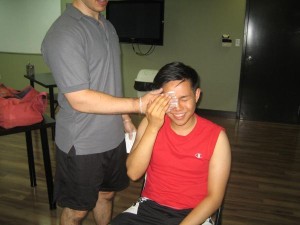Dry eyes syndrome is a disorder of the tear film of the eyes. Dry eyes occur when the tears are incapable of supplying sufficient moisture for the eyes.There are many occurrences that may lead to insufficient tears production, which will be discussed later. Women are more prone dry eye syndrome.Dry eyes may lead to discomfort and may be painful. Dry eye syndrome is usually not serious and treatment is available for dry eye syndrome.
Three layers of the tear film
Tears are necessary to keep the eyes lubricated and to wash away any foreign particles.A healthy tear film is essential for keeping the eyes comfortable and having a good vision. Damage or injury to any one of the three layers may lead to dry eye syndrome.
- Innermost
- Thinnest layer
- Mucus produced by the conjunctiva
- Aids in spreading watery layer evenly over the eye
- Middle (aqueous)
- Largest and thickest layer
- Water layer produced by lacrimal glands
- Keeps eyes moist and comfortable while removing any foreign particles that may get into the eye
- Most superficial
- Thin layer of lipids
- Reduces evaporation of the middle layer
Disclaimer: The following information should not be used for medical diagnosis or medical advice. To learn more about eye injuries, enroll in First Aid Courses.
Causes of Dry Eye Syndrome
Dry eye syndrome can result from reduced tear production, extreme tear production or abnormal mucus or lipid production in the tear film. Some of the specific causes include:
- Increasing age
- Hormonal changes
- Autoimmune diseases
- Certain medications such as, antihistamines, antidepressants, beta-blockers and oral contraceptives
- Not blinking often
- Chemical or thermal burns to the eyes
- Dry environment or workplace
- Sun exposure
- Exposure to smoke
- Blepharitis
- Previous eye injury
Symptoms of Dry Eye Syndrome
The following symptoms may occur when one has dry eye syndrome:
- Itching, burning or redness in the eye
- Dry, scratchy feeling in the eye
- Sensation that something is lodged in the eye
- Blurred vision
- Photosensitivity
First Aid Treatment and Management for Dry Eye Syndrome
Although dry eye syndrome is generally harmless and frequently does not lead

to complications, first aid should be given to ease symptoms and provide comfort to the person.
- Apply hot compresses to the eyes. The eyelids may also be massaged with baby shampoo. Do this two to four times a day.
- Artificial tears and eye drops may be placed on the eye surface to give added moisture to the eyes. Do this method four times a day.
- If eyes become dry from prolonged reading or watching TV, take regular breaks to allow the eyes to rest and become moist again. Eyes may be closed for 10 seconds every five to ten minutes.
- Set up a humidifier, especially while sleeping, to add moisture to the air.
- Avoid excessive air movement because these tend to dry out the eyes.
- Minimize using medications that may lead to dry eye syndrome.
